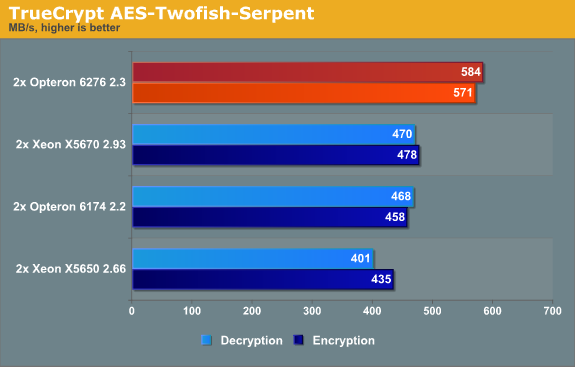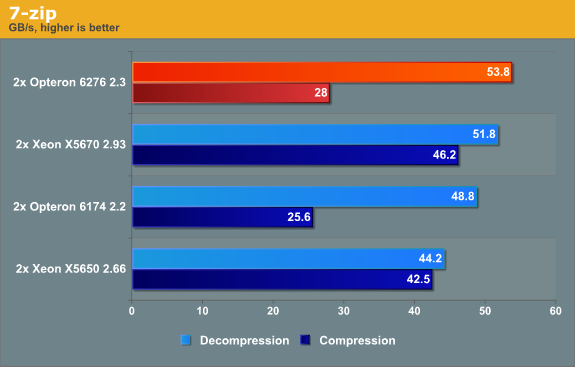Bulldozer for Servers: Testing AMD's "Interlagos" Opteron 6200 Series
by Johan De Gelas on November 15, 2011 5:09 PM ESTTrueCrypt 7.1 Benchmark
TrueCrypt is a software application used for on-the-fly encryption (OTFE). It is free, open source and offers full AES-NI support. The application also features a built-in encryption benchmark that we can use to measure CPU performance. First we test with the AES algorithm (256-bit key, symmetric).

You can compare those numbers directly with Anand's benchmark here. The Core i7-2600K at 3.4GHz delivers 3.4GB/s and the AMD FX-8150 at 3.6GHz about the same 3.3GB/s. We get about 2.3 times the performance here with four times as many "cores", but at 2.3GHz instead of 3.6GHz.
We also test with the heaviest combination of the cascaded algorithms available: Serpent-Twofish-AES.

The combination benchmark is limited by the slowest algorithms: twofish and serpent. The huge advantage that the architectures (Opteron "Bulldozer" and Xeon "Westmere") which support AES-NI had has evaporated: the Opteron 6174 keeps up with the best Xeons. The Opteron 6276 can leverage its higher threadcount as this benchmark scales extremely well.
It is good to realize that these benchmarks are not real-world but rather synthetic. It would be better to test a website that does some encrypting in the background or a fileserver with encrypted partitions. In that case the encryption software is only a small part of the total code being run. A large performance (dis)advantage might translate into a much smaller performance (dis)advantage in that real-world situation.
For example, eight times faster encryption resulted in a website with 23% higher throughput and a 40% faster encrypted file (see here). The advantage that the Xeon had in the first benchmark will not be noticeable, and the Opteron's 24% higher performance will translate into a few percentage points. But this is a benchmark where AMD's efforts to get a 16 integer cores inside a 115W TDP pay off.
7-Zip 9.2
7-zip is a file archiver with a high compression ratio. 7-Zip is open source software, and most of the source code is under the GNU LGPL license

Compression is more CPU intensive than decompression, and the latter depends a little more on memory bandwidth. When it comes to load/stores and memory bandwidth, the Opteron 6276 is unbeateable. We've also seen indications that Bulldozer's cache does very well in reads but not so well in writes, and that could account for some of the gap between the compress/decompress results.
Compression is for a part determined by the quality of the branch predictor (higher than normal branch mispredictions on mediocre branch predictors). The Opteron 6276 has a better branch predictor than the Opteron 6174, but the branch misprediction penalty has grown from 12 to 20 cycles. As a result, a single branch intensive thread runs slower (see Anand's tests) on the newest AMD architecture. Luckily, the AMD Opteron 6276 can compensate for this with its 16 threads (vs 12 threads for the Opteron 6172) and a little bit of help from Turbo Core.
Intel still has the best branch predictors in the industry. The result is that the Xeon is by far the fastest compressor. The end result is that the Xeon is the more rounded CPU in this discipline.










106 Comments
View All Comments
neotiger - Tuesday, November 15, 2011 - link
Most of the benchmarks are for rendering: Cinebench, 3DSMax, Maxwell, Blender, etc.How many enterprises actually do 3D rendering?
Far more common enterprise applications would be RDBMS, data warehouse, OLTP, JVM, app servers, etc.
You touched on some of that in just one virtualization benchmark, vApus. That doesn't make sense either - how many enterprises you know run database servers on VM?
A far more useful review would be running separate benchmarks for OLTP, OLAP, RDBMS, JVM, etc. tppc, tpce, tpch would be a good place to start
JohanAnandtech - Tuesday, November 15, 2011 - link
I definitely would like to stay close to what people actually use.In fact we did that:
http://www.anandtech.com/show/2694
But the exploding core counts made it as good as impossible.
1. For example, a website that scales to 32 cores easily: most people will be amazed how many websites have trouble scaling beyond 8 cores.
2. Getting an OLTP database to scale to 32 cores is nothing to sneeze at. If your database is small and you run most of it in memory, chances are that you'll get a lot of locks and that it won't scale anyway. If not, you'll need several parallel RAID cards which have a lot of SSDs. We might pull that one off (the SSDs), but placing several RAID cards inside a server is most of the time not possible. once you solve the storage bottleneck, other ones will show up again. Or you need an expensive SAN... which we don't have.
We had an OLAP/ OLTP and Java benchmarks. And they were excellent benchmarks, but between 8 and 16 cores, they started to show decreasing CPU utilization despite using SSDs, tweaking etc.
Now puts yourself in our place. We can either spend weeks/months getting a database/website to scale (and we are not even sure it will make a real repeatable benchmark) or we can build upon our virtualization knowledge knowing that most people can't make good use of a native 32 core database anyway (or are bottlenecked by I/O and don't care anyway), and buy their servers to virtualize.
At a certain point, we can not justify to invest loads of time in a benchmark that only interest a few people. Unless you want to pay those people :-). Noticed that some of the publications out there use geekbench (!) to evaluate a server? Noticed how many publication run virtualization benchmarks?
"That doesn't make sense either - how many enterprises you know run database servers on VM?"
Lots of people. Actually besides a few massive Oracle OLTP databases, there is no reason any more not to virtualized your databases. SQL server and MySQL are virtualized a lot. Just googling you can find plenty of reports of MySQL and SQL server on top of ESX 4. Since vSphere 4 this has been common practice.
"etc. tppc, tpce, tpch would be a good place to start "
No not really. None of the professional server buyers I know cares about TPC benches. The only people that mentione them are the marketing people and hardware enthusiast that like to discuss high-end hardware.
So you prefer software that requires 300.000$ of storage hardware over a very realistic virtualization benchmarks which are benchmarked with real logs of real people?
Your "poor benchmark choice" title is disappoing after all the time that my fine colleagues and me have spend on getting a nice website + groupware virtualization benchmark running which is stresstested by vApus which uses real logs of real people. IMHO, the latter is much more interesting than some inflated TPC benchmarks with storage hardware that only the fortune 500 can afford. Just HMO.
neotiger - Tuesday, November 15, 2011 - link
While scaling to 32 cores can be problematic for some software, it's worth keeping in mind that the vast majority of dual-socket servers don't have 32 cores.In fact, a dual-CPU Intel server only has *at most* 12 cores, that's a far cry from 32-cores. Postgresql & MySQL has no problem at all to scale to 12 cores and beyond.
Now if AMD decided to make a CPU with crappy per-core performance but has so many cores that most software can't take full advantage of, that's their own fault. It's not like they haven't been warned. Sun tried and failed with the same approach with T2. If AMD is hellbent on making the same mistake, they only have themselves to blame.
My post title is a bit harsh. But it is disappointing to see a review that devotes FOUR separate benchmarks to 3D rendering, an application that the vast majority of enterprises have no use for at all. Meanwhile, the workhorse applications for most enterprises, OLTP, OLAP, and such, received far too little attention.
tiro_uspsss - Wednesday, November 16, 2011 - link
"In fact, a dual-CPU Intel server only has *at most* 12 cores..."Incorrect. There is s1567. This allows 2-8 CPUs, with a max. of 8C/16T per CPU......... which I'm wondering why Anandtech failed to include in this review?
s1567 CPUs also have quad channel memory...
I really wish s1567 was included in this review..
Photubias - Wednesday, November 16, 2011 - link
Intel's S1567?You mean the E7-8830 CPU from the E7-8800 series which has prices *starting* at $2280?
-> http://ark.intel.com/products/series/53672
bruce24 - Wednesday, November 16, 2011 - link
"You mean the E7-8830 CPU from the E7-8800 series which has prices *starting* at $2280?"I'm not sure what he meant, but there are E7-2xxx processors for dual socket servers, which are priced much lower than the E7-8xxx processors which are for 8+ socket servers.
Photubias - Thursday, November 17, 2011 - link
You mean the E7-28xx serieshttp://ark.intel.com/products/series/53670 ?
They are priced a bit lower, is there a comparison you suggest?
Sabresiberian - Wednesday, November 16, 2011 - link
I have trouble understanding why people think a review should include research into every other similar product that might be used for the same purpose.I mean, I can understand ASKING for a review of another specific product, particularly if you've actually done some research on your own and haven't found the information you want, but to imply a review isn't complete because it didn't mention or test another piece of hardware is a bit - unrealistic.
;)
JohanAnandtech - Thursday, November 17, 2011 - link
Sabresiberian, a very sincere thank you for being reasonable. :-)Frankly I can't imagine a situation where someone would have trouble to decide between a Westmere-EX and an AMD CPU. Most people checking out the Westmere-EX go for the RAS features (dual) or RAS + ultimate high thread performance (Quad). In all other cases dual Xeon EP or Opterons make more sense power and pricewise.
JustTheFacts - Thursday, November 17, 2011 - link
Really? Is it that much trouble to understand that people want to see the latest AMD cpu's compared to the most current generation of Intel hardware? Especially when the previous Intel processor review posted on this site reported on Westmere-EX performance? I have trouble understanding why people wouldn't expect it.